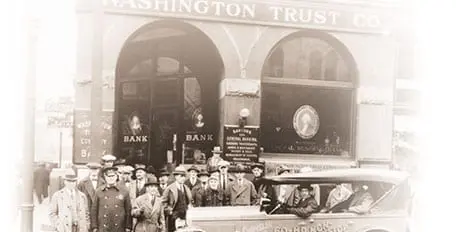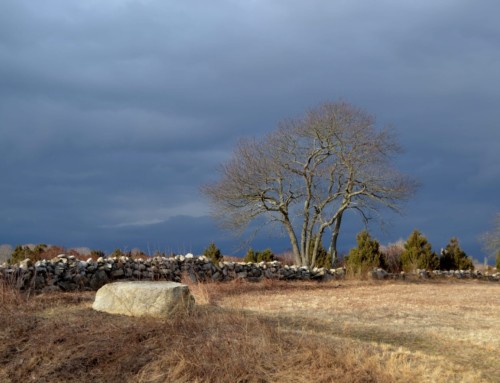Two hundred and twenty years. That is the length of time that the Washington Trust Company has been serving the people of southern New England. For more than two centuries, through 44 presidential administrations and the addition of 34 states to the union, Westerly’s oldest bank has continued to be a community institution.
In 1800, the Washington Bank was founded in Westerly with a total of $50,000 in capital in preparation to serve the citizens of Westerly.[1] The bank was the fourth incorporated in the State of Rhode Island, less than a decade after Providence Bank was established on October 3, 1791.[2] On June 21, 1800, the bank selected their first directors, with Rowse Babcock being named President and Arnold Clarke of Stonington chosen as the cashier.[3]
Two months later on August 22, the bank opened its doors to the public operating out of a room at the lower front of the Paul Rhodes Hotel on Broad Street at the site which would later be occupied by the Dixon House.[4] This would be the home of the bank for the next 36 years.
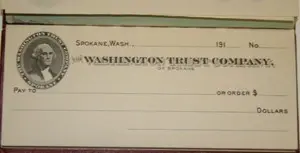
Although he was a skilled engraver when it came to lettering and scrolls, his lack of experience in portraiture was not given consideration when contracting Doolittle, resulting in some less than flattering depictions.
On June 13, 1801, less than a year after the bank opened for business, President Rowse Babcock died at the age of 55 and he was replaced shortly thereafter by board member Thomas Noyes, a distinguished officer during the Revolutionary War.[8] One notable event of Babcock’s brief presidency occurred on George Washington’s Birthday (February 22) 1801, when the Washington Bank issued its first dividend.[9]
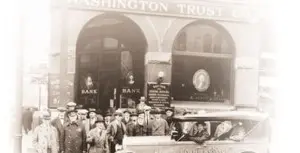
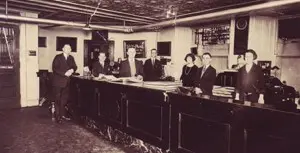
Charles Perry Sr. was later chosen as President in 1881, freeing up the cashier position which was then filled by his son, Charles Perry Jr. who would follow in the footsteps of his father, acting first as vice president from 1904 to 1906 before a tenure as President which lasted from 1906 to 1929.[13] Charles Perry Jr. was only the third in a long line of Perrys working for the Washington Trust Company.
Charles Jr.’s son, Arthur L. Perry held several officer positions before succeeding his father as President in 1929, and Arthur’s son, Robert B. “Bob” Perry was also named president in 1963.[14] Robert Perry’s son, Harvey C. Perry, also served as an Officer at the bank, representing the sixth generation of Perrys, as he was the great-great-great-grandson of Thomas Perry.[15]
[su_accordion class=””] [su_spoiler title=”Footnotes” open=”no” style=”default” icon=”plus” anchor=”” class=””]
- “The Washington Trust Company of Westerly, Rhode Island” The Banker’s Magazine, vol. LXXXIII, 1911, pg. 248.
- Rhode Island Currency, Timeline of Rhode Island Banking, https://www.ricurrency.com/timeline-of-rhode-island-banking/.
- Washington Trust, Celebrating 200 Years of Service, Westerly Sun Insert, 20 August 2000.
- The Washington Trust Company, One Hundred Years of Banking in Westerly, (Westerly, RI, 1908).
- Washington Trust, Celebrating 200 Years of Service, Westerly Sun Insert, 20 August 2000.
- Paper Money, Sept./Oct. 1981, pg. 252.
- Washington Trust, Celebrating 200 Years of Service, Westerly Sun Insert, 20 August 2000.
- The Washington Trust Company, One Hundred Years of Banking in Westerly, (Westerly, RI, 1908), and Rhode Island Historic Cemetery Commission, Gravestone of Rowse Babcock, http://rihistoriccemeteries.org/newgravedetails.aspx?ID=361513.
- The Washington Trust Company, One Hundred Years of Banking in Westerly, (Westerly, RI, 1908).
- Cooney, Ralph Bolton, Westerly’s Oldest Witness: How Westerly and the Washington Trust Company Have Progressed Together for 150 Years, (1950), pg. 62.
- Cooney, Ralph Bolton, Westerly’s Oldest Witness: How Westerly and the Washington Trust Company Have Progressed Together for 150 Years, (1950), pg. 16.
- “The Washington Trust Company of Westerly, Rhode Island” The Banker’s Magazine, vol. LXXXIII, 1911, pg. 249.
- Cooney, Ralph Bolton, Westerly’s Oldest Witness: How Westerly and the Washington Trust Company Have Progressed Together for 150 Years, (1950), pg. 80.
- Cooney, Ralph Bolton, Westerly’s Oldest Witness: How Westerly and the Washington Trust Company Have Progressed Together for 150 Years, (1950), pg. 80.
- Chalk, Sandra Kersten, Washington Trust: Two Hundred Years Along the Pawcatuck, (2000), pg. 62.
- George Thurston and Sons Records, Rhode Island Historical Society, Mss 733 Scope.
[/su_spoiler] [/su_accordion]
